Randalthor
Cast Iron
- Joined
- Mar 7, 2018
- Location
- Kansas City
There's probably a bazillion threads on head refurbishment, but perhaps I can add a little help to new BP hobbyists who are planning to tear into the head. My input is in no way definitive, I'm as new to this as anyone. I also have some questions at the end for any of the experts here please. The first part is just for anyone new, like me, so everyone else can scroll down to the questions if you want.
I bought this Bridgeport mill a couple of weeks ago and posted about the purchase and my basic tear down of the mill here.
http://www.practicalmachinist.com/v...hes/another-bridgeport-price-question-347638/
I'm a little further along now (have other obligations so can't work on it as much as I'd like). I currently have all the bearings replaced in the gear assembly and have the gear assembly back together.
![KIMG0698[1].jpg KIMG0698[1].jpg](https://www.practicalmachinist.com/forum/data/attachments/188/188353-dba3adf7df767e50240ca29c794f2c1f.jpg)
Disassembly generally wasn't hard. You obviously need to have a little mechanical knowledge (little things like orienting snap rings the correct way are assumed knowledge). You need to have equip. to press bearings out, and things to match the races of the bearings. Various pieces of pvc pipe or a 3/4" socket set works most of the time. I watched all the H&W machine videos, plus another set of videos put out by the Machinery Repair Shop, and read the book, "Guide to Renovating the Bridgeport 2J". If you are doing the work for the first time, get the book, it's worth the $25. I also recommend lots of plastic sandwich bags to put parts in, and a marker to label bags. Also a good idea to take lots of pictures during disassembly. This may not help if the head has been apart before, as there is no guarantee of the competency of the previous work.
One thing the book recommends is buying a 2" i.d. automotive lock nut socket to take off the slotted lock nut on the bull gear assembly, and not to use a punch and hammer to remove the nut (like I've done many times). I decided to follow the book's advice and bought the socket for $15. The socket didn't fit perfectly, so I had to touch up the dogs on a grinder to make it fit the nut. The socket was extremely helpful. It took a lot of force with a 2' breaker bar to loosen the nut. Even with the socket, it deformed the slots in the nut some. I can't imagine how that nut would have looked had I tried to remove it with a hammer and punch.
![KIMG0700[1].jpg KIMG0700[1].jpg](https://www.practicalmachinist.com/forum/data/attachments/188/188355-6bc17c7f0f0fd438f1dff0f533672bcd.jpg)
In reassembling the bull gear assembly, I was a little unclear where to put the wavy washer. If you look very carefully in slow motion on this H&W video, the wavy washer comes out at exactly 1:38 It comes out right after the bearing in the end opposite the flange, of the bearing housing.
Disassembly of the Large Bull Gear Housing - YouTube
Likewise, in this video by Machinery Repair Shop the wavy washer comes out at the same location on the end opposite the flange. (17:31).
Bridgeport Mill Variable speed drive (2J) disassembly part 3 - Back Gear disassembly - YouTube
Those two examples are exactly how mine came apart as well.
However, regarding the washer, the book says, "On the bottom of the sleeve (the flanged end) first install the WAVE SPRING WASHER on top of the snap ring, and then press a new 6908 double sealed ball bearing into the sleeve pressing only on the outer race." (emphasis in the original)
They even show pictures reinforcing their instructions to put the washer on the flange end, instead of the other end, like mine came apart.
![KIMG0701[1].jpg KIMG0701[1].jpg](https://www.practicalmachinist.com/forum/data/attachments/188/188357-b6dd0eb5a56e26edd7a919595b9779f4.jpg)
This caused me some consternation and fretting, especially since the book was emphatic on the point. Do I put it back together like it came apart, or follow the instructions of the book? I looked carefully at the Bridgeport schematic, and contrary to the book (and like the videos) it shows the washer belongs in the end opposite the flanged end (#58 in the drawing below). I decided to go with the way Bridgeport installed it and put it on the non-flanged end.

Maybe it's not that big a deal, the Machinery Repair Shop rebuilder doesn't even put the wavy washer back in at all. (See vid starting at 1:07 and again at 6:00)
Bridgeport Mill Variable speed drive (2J) reassembly part 2 - Back Gear assembly - YouTube
On another issue, I've not been unable to find are any torque values for the fasteners on the head (except where the head mounts to the base). The actual Bridgeport service manual probably has that information, but I don't have that book. I've just been torquing them by feel according to the size of the fastener. I also use a bit of blue loctite with the fasteners, which may be controversial, but I don't like fasteners coming loose by themselves. Even the slotted nut on the bull gear assembly I mentioned earlier seems to have come loose in this vid. (see 0.32 min)
Disassembly of the Large Bull Gear Housing - YouTube
Now for the questions.
The book says to fill the lower gear assembly with grease till it comes halfway up on the bull gear teeth, when the bull gear is in the upper position (high gear) and pack it in the pinion gear. I did that, but when I lowered the bull gear to engage the pinion gear, the grease really pushed up and over the top of the bull gear. The book says not to get grease on top of the bull gear, so I ended up taking a little bit of the grease back out. How do you know if you have the right amount of grease in there?
Secondly, and probably more importantly, I have a question on removing the spindle. I have the head tore down enough, that I could take the spindle out in 10 min. I've already had the nose cap off the quill to replace the collet alignment screw (it wasn't broken off, but badly worn). It would not take much more to tap the spindle out. I'd like to remove the spindle to examine the bearings, but I read on the PM forum once that you should not remove the spindle unless you absolutely have to. I've also read that a properly aligned spindle has to have the taper reground "in situ" with the quill.
I don't think this spindle has ever been out of this machine, so I don't want to screw up the alignment. I couldn't read any spindle runout on a magnetic indicator, so I think it's aligned fairly well. The reason I'd like to take it out to examine the bearings is that the timing pulley clutch sleeve (see #38 in the schematic drawing above) had come off at some point and ground a little bit off by hitting the bull gear below(the sleeve didn't touch the dogs on the bull gear hub (#39), the dogs are in very good shape on the upper and lower shaft and have a very tight fit).
![KIMG0702[1].jpg KIMG0702[1].jpg](https://www.practicalmachinist.com/forum/data/attachments/188/188368-203c0e92700e0666d515f794622011bf.jpg)
I bought a new sleeve and plan to use bearing retaining compound to keep it on the upper shaft, but the problem is when the old sleeve ran against the bull gear it scraped some shavings off and I found these in the felt washer below. Moreover, some of the metal shavings made it past the felt washer and I found them in the quill nose cap, which I had removed to take out the worn collet alignment screw. I'm concerned there could still be some metal shavings on top of the lower spindle bearing, and would like to remove the spindle to examine (as I mentioned I have just about everything apart anyway). I just don't want to do it if it could throw the spindle out of alignment. Can someone who has experience in this please tell me the likelihood the spindle will come out of alignment with the quill by removing it? It's probably been discussed here many times already, but I searched for quite a while and couldn't find a thread which discussed it.
I bought this Bridgeport mill a couple of weeks ago and posted about the purchase and my basic tear down of the mill here.
http://www.practicalmachinist.com/v...hes/another-bridgeport-price-question-347638/
I'm a little further along now (have other obligations so can't work on it as much as I'd like). I currently have all the bearings replaced in the gear assembly and have the gear assembly back together.
![KIMG0698[1].jpg KIMG0698[1].jpg](https://www.practicalmachinist.com/forum/data/attachments/188/188353-dba3adf7df767e50240ca29c794f2c1f.jpg)
Disassembly generally wasn't hard. You obviously need to have a little mechanical knowledge (little things like orienting snap rings the correct way are assumed knowledge). You need to have equip. to press bearings out, and things to match the races of the bearings. Various pieces of pvc pipe or a 3/4" socket set works most of the time. I watched all the H&W machine videos, plus another set of videos put out by the Machinery Repair Shop, and read the book, "Guide to Renovating the Bridgeport 2J". If you are doing the work for the first time, get the book, it's worth the $25. I also recommend lots of plastic sandwich bags to put parts in, and a marker to label bags. Also a good idea to take lots of pictures during disassembly. This may not help if the head has been apart before, as there is no guarantee of the competency of the previous work.
One thing the book recommends is buying a 2" i.d. automotive lock nut socket to take off the slotted lock nut on the bull gear assembly, and not to use a punch and hammer to remove the nut (like I've done many times). I decided to follow the book's advice and bought the socket for $15. The socket didn't fit perfectly, so I had to touch up the dogs on a grinder to make it fit the nut. The socket was extremely helpful. It took a lot of force with a 2' breaker bar to loosen the nut. Even with the socket, it deformed the slots in the nut some. I can't imagine how that nut would have looked had I tried to remove it with a hammer and punch.
![KIMG0700[1].jpg KIMG0700[1].jpg](https://www.practicalmachinist.com/forum/data/attachments/188/188355-6bc17c7f0f0fd438f1dff0f533672bcd.jpg)
In reassembling the bull gear assembly, I was a little unclear where to put the wavy washer. If you look very carefully in slow motion on this H&W video, the wavy washer comes out at exactly 1:38 It comes out right after the bearing in the end opposite the flange, of the bearing housing.
Disassembly of the Large Bull Gear Housing - YouTube
Likewise, in this video by Machinery Repair Shop the wavy washer comes out at the same location on the end opposite the flange. (17:31).
Bridgeport Mill Variable speed drive (2J) disassembly part 3 - Back Gear disassembly - YouTube
Those two examples are exactly how mine came apart as well.
However, regarding the washer, the book says, "On the bottom of the sleeve (the flanged end) first install the WAVE SPRING WASHER on top of the snap ring, and then press a new 6908 double sealed ball bearing into the sleeve pressing only on the outer race." (emphasis in the original)
They even show pictures reinforcing their instructions to put the washer on the flange end, instead of the other end, like mine came apart.
![KIMG0701[1].jpg KIMG0701[1].jpg](https://www.practicalmachinist.com/forum/data/attachments/188/188357-b6dd0eb5a56e26edd7a919595b9779f4.jpg)
This caused me some consternation and fretting, especially since the book was emphatic on the point. Do I put it back together like it came apart, or follow the instructions of the book? I looked carefully at the Bridgeport schematic, and contrary to the book (and like the videos) it shows the washer belongs in the end opposite the flanged end (#58 in the drawing below). I decided to go with the way Bridgeport installed it and put it on the non-flanged end.

Maybe it's not that big a deal, the Machinery Repair Shop rebuilder doesn't even put the wavy washer back in at all. (See vid starting at 1:07 and again at 6:00)
Bridgeport Mill Variable speed drive (2J) reassembly part 2 - Back Gear assembly - YouTube
On another issue, I've not been unable to find are any torque values for the fasteners on the head (except where the head mounts to the base). The actual Bridgeport service manual probably has that information, but I don't have that book. I've just been torquing them by feel according to the size of the fastener. I also use a bit of blue loctite with the fasteners, which may be controversial, but I don't like fasteners coming loose by themselves. Even the slotted nut on the bull gear assembly I mentioned earlier seems to have come loose in this vid. (see 0.32 min)
Disassembly of the Large Bull Gear Housing - YouTube
Now for the questions.
The book says to fill the lower gear assembly with grease till it comes halfway up on the bull gear teeth, when the bull gear is in the upper position (high gear) and pack it in the pinion gear. I did that, but when I lowered the bull gear to engage the pinion gear, the grease really pushed up and over the top of the bull gear. The book says not to get grease on top of the bull gear, so I ended up taking a little bit of the grease back out. How do you know if you have the right amount of grease in there?
Secondly, and probably more importantly, I have a question on removing the spindle. I have the head tore down enough, that I could take the spindle out in 10 min. I've already had the nose cap off the quill to replace the collet alignment screw (it wasn't broken off, but badly worn). It would not take much more to tap the spindle out. I'd like to remove the spindle to examine the bearings, but I read on the PM forum once that you should not remove the spindle unless you absolutely have to. I've also read that a properly aligned spindle has to have the taper reground "in situ" with the quill.
I don't think this spindle has ever been out of this machine, so I don't want to screw up the alignment. I couldn't read any spindle runout on a magnetic indicator, so I think it's aligned fairly well. The reason I'd like to take it out to examine the bearings is that the timing pulley clutch sleeve (see #38 in the schematic drawing above) had come off at some point and ground a little bit off by hitting the bull gear below(the sleeve didn't touch the dogs on the bull gear hub (#39), the dogs are in very good shape on the upper and lower shaft and have a very tight fit).
![KIMG0702[1].jpg KIMG0702[1].jpg](https://www.practicalmachinist.com/forum/data/attachments/188/188368-203c0e92700e0666d515f794622011bf.jpg)
I bought a new sleeve and plan to use bearing retaining compound to keep it on the upper shaft, but the problem is when the old sleeve ran against the bull gear it scraped some shavings off and I found these in the felt washer below. Moreover, some of the metal shavings made it past the felt washer and I found them in the quill nose cap, which I had removed to take out the worn collet alignment screw. I'm concerned there could still be some metal shavings on top of the lower spindle bearing, and would like to remove the spindle to examine (as I mentioned I have just about everything apart anyway). I just don't want to do it if it could throw the spindle out of alignment. Can someone who has experience in this please tell me the likelihood the spindle will come out of alignment with the quill by removing it? It's probably been discussed here many times already, but I searched for quite a while and couldn't find a thread which discussed it.
Last edited:


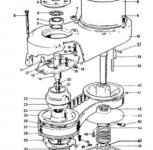
![KIMG0705[1].jpg KIMG0705[1].jpg](https://www.practicalmachinist.com/forum/data/attachments/188/188387-f89b1eb94ce4235977a431a595bf3e15.jpg)

![KIMG0715[1].jpg KIMG0715[1].jpg](https://www.practicalmachinist.com/forum/data/attachments/188/188437-ee5b1e343247a3d35f8643913659b27d.jpg)
![KIMG0710[1].jpg KIMG0710[1].jpg](https://www.practicalmachinist.com/forum/data/attachments/188/188438-179e91d2c6470e36e3950515e34974be.jpg)

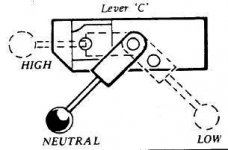


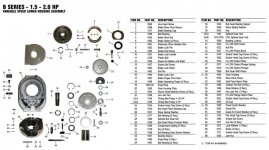
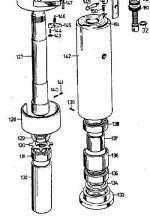

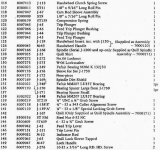
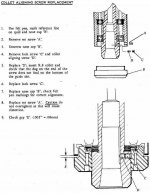
![KIMG0716[1].jpg KIMG0716[1].jpg](https://www.practicalmachinist.com/forum/data/attachments/188/188587-f7535a8064d87bcf91304fb3cbaf3475.jpg)
![KIMG0719[1].jpg KIMG0719[1].jpg](https://www.practicalmachinist.com/forum/data/attachments/188/188598-d16f0ce2d65d86013e46c5348f933fb9.jpg)
![KIMG0720[1].jpg KIMG0720[1].jpg](https://www.practicalmachinist.com/forum/data/attachments/188/188602-5dad9341add27aad096f764d46642c5d.jpg)
![KIMG0723[1].jpg KIMG0723[1].jpg](https://www.practicalmachinist.com/forum/data/attachments/188/188643-e450a077b306235fd7773722d7f075a0.jpg)
![KIMG0732[1].jpg KIMG0732[1].jpg](https://www.practicalmachinist.com/forum/data/attachments/188/188706-ef72d2c22326f05eb3ef9254eed9115e.jpg)